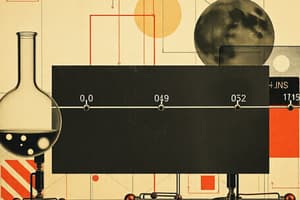Podcast
Questions and Answers
How does a decrease in temperature affect an exothermic reaction?
How does a decrease in temperature affect an exothermic reaction?
- Increases yield of reaction
- Causes the reaction to stop
- Decreases yield of reaction (correct)
- No effect on yield of reaction
In gaseous reactions, what happens if there is an increase in pressure?
In gaseous reactions, what happens if there is an increase in pressure?
- Reaction becomes irreversible
- Equilibrium shifts to side with fewer moles of gas (correct)
- Equilibrium shifts to side with more moles of gas
- No effect on equilibrium
For a reaction that produces more moles of gas, what happens if the pressure is increased?
For a reaction that produces more moles of gas, what happens if the pressure is increased?
- Equilibrium shifts to side with more moles of gas (correct)
- Reaction stops
- No effect on equilibrium
- Equilibrium shifts to side with fewer moles of gas
What happens to the yield of an endothermic reaction if the temperature is decreased?
What happens to the yield of an endothermic reaction if the temperature is decreased?
When pressure decreases in a gaseous reaction, where does the equilibrium shift?
When pressure decreases in a gaseous reaction, where does the equilibrium shift?
If a reaction produces fewer moles of gas, what happens when pressure is increased?
If a reaction produces fewer moles of gas, what happens when pressure is increased?
In which direction does the equilibrium shift if a reaction produces more moles of gas and pressure is increased?
In which direction does the equilibrium shift if a reaction produces more moles of gas and pressure is increased?
In a closed system, when does equilibrium occur for a reversible reaction?
In a closed system, when does equilibrium occur for a reversible reaction?
What happens when a reversible reaction reaches equilibrium in a closed system?
What happens when a reversible reaction reaches equilibrium in a closed system?
How do changing conditions affect the relative amounts of reacting substances at equilibrium?
How do changing conditions affect the relative amounts of reacting substances at equilibrium?
If a reversible reaction is exothermic, what happens at equilibrium if the temperature is increased?
If a reversible reaction is exothermic, what happens at equilibrium if the temperature is increased?
What is the impact on equilibrium when a reversible reaction takes place in an open system?
What is the impact on equilibrium when a reversible reaction takes place in an open system?
What happens to the position of equilibrium when the concentration of reactants is increased?
What happens to the position of equilibrium when the concentration of reactants is increased?
How does increasing the concentration of products affect the position of equilibrium?
How does increasing the concentration of products affect the position of equilibrium?
If a reaction is endothermic and the temperature is increased, what is the effect on equilibrium?
If a reaction is endothermic and the temperature is increased, what is the effect on equilibrium?
In Le Chatelier's principle, what does the system do when a change is made to any of the conditions of equilibrium?
In Le Chatelier's principle, what does the system do when a change is made to any of the conditions of equilibrium?
For an exothermic reaction, what happens if the temperature is decreased?
For an exothermic reaction, what happens if the temperature is decreased?
When a system is no longer at equilibrium due to a change in concentration, what occurs until equilibrium is reached again?
When a system is no longer at equilibrium due to a change in concentration, what occurs until equilibrium is reached again?
In a gaseous reaction that produces the least number of molecules, what happens to the equilibrium if the pressure is increased?
In a gaseous reaction that produces the least number of molecules, what happens to the equilibrium if the pressure is increased?
For a reaction producing a larger volume of gas (more moles), what happens if the pressure is decreased?
For a reaction producing a larger volume of gas (more moles), what happens if the pressure is decreased?
How does a decrease in temperature affect the yield of an endothermic reaction?
How does a decrease in temperature affect the yield of an endothermic reaction?
When a decrease in pressure occurs in a gaseous reaction, where does the equilibrium shift?
When a decrease in pressure occurs in a gaseous reaction, where does the equilibrium shift?
If a reaction produces fewer moles of gas, what happens when the pressure is increased?
If a reaction produces fewer moles of gas, what happens when the pressure is increased?
What is the effect of pressure changes on equilibrium in gaseous reactions?
What is the effect of pressure changes on equilibrium in gaseous reactions?
What symbol is typically used to represent a reversible reaction?
What symbol is typically used to represent a reversible reaction?
How can the direction of a reversible reaction be altered?
How can the direction of a reversible reaction be altered?
In which type of reactions can the products react to form the original reactants?
In which type of reactions can the products react to form the original reactants?
If a reversible reaction is endothermic in one direction, what is it in the opposite direction?
If a reversible reaction is endothermic in one direction, what is it in the opposite direction?
What type of change occurs if a reversible reaction is endothermic one way?
What type of change occurs if a reversible reaction is endothermic one way?
What is the relationship between an endothermic reaction and an exothermic reaction in a reversible reaction?
What is the relationship between an endothermic reaction and an exothermic reaction in a reversible reaction?
Flashcards are hidden until you start studying




